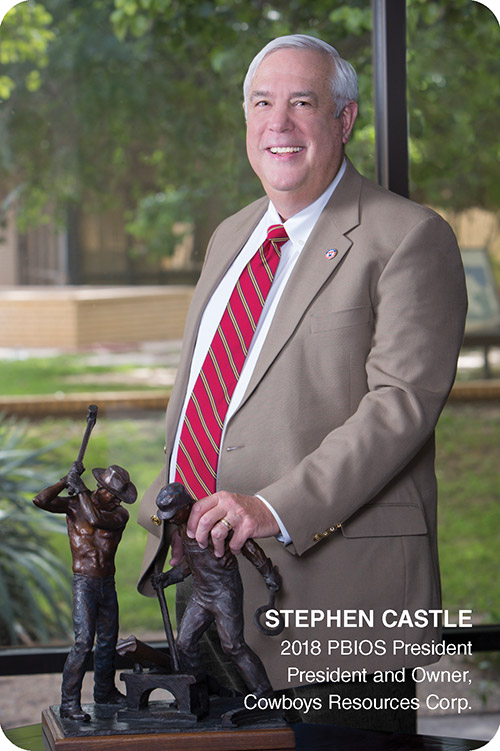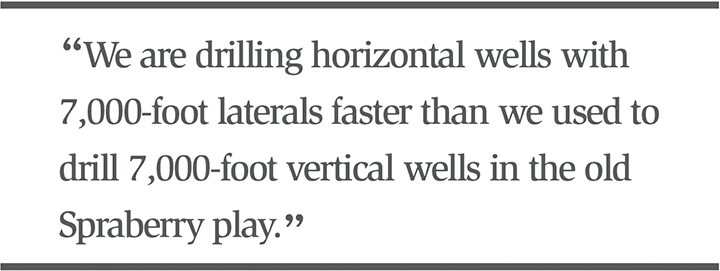
PBIOS Preview
Castle Guides 2018 PBIOS Through Record-Setting Times In Red-Hot Permian Basin
By Danny Boyd, Special Correspondent
MIDLAND–The official theme of the 2018 Permian Basin International Oil Show–“We’re Back”–demonstrates how innovations in oil and gas technology, equipment and systems are changing everything. As the course of reinvention and retooling continues for both conventional and unconventional upstream operations, infrastructure needs are impacting both ends of the industry pipeline.
PBIOS President Stephen Castle is quick to point out that it is the dedication of the working men and women from the rig floor to the field office and executive suite who collectively are the driving force behind all the positive changes. While the Permian “global superbasin” is the poster child of America’s ingenuity and resource potential, the U.S. oil and gas industry as a whole has emerged as an energy-producing and energy-exporting powerhouse.
Set for Oct. 16-18 at the Ector County Coliseum and Fairgrounds in Odessa, Tx., PBIOS is expected to draw visitors representing all industry sectors around the world and already has received interest from national media, Castle says.
While the show always has attracted industry attention, the sharp upswing in Permian activity since the 2016 show gained the world’s interest as basin players went back to work with a vengeance in the lucrative stacked tight oil plays, he points out. In mid-summer, the Permian accounted for half of all U.S. working rigs, with more than 50 drilling each week in Midland County alone. Permian oil and gas production are on a tear, rocketing to new all-time highs almost by the month. The basin is attracting two of every ten dollars invested globally in upstream services and equipment.
By any measure, the Permian is back and in a very big way. The only objection one may have with the 2018 PBIOS theme is that it doesn’t end with an exclamation point . . . or two!
“We are extremely busy in the basin, and that is what our theme is all about. But it’s not meant to put down other basins or energy sectors,” emphasizes Castle, a lifelong oil patch veteran and president and owner of Cowboys Resources Corporation, a Midland-based working-interest investment company. “We need all kinds of oil and gas basins and all kinds of energy.”
In July, all available vendor space was committed and 200 companies were on a waiting list, says PBIOS Executive Director Anthony Fry. More than 1,100 spaces will be occupied by 739 exhibitors showcasing geophysical services, logging equipment, rigs, trucks, heavy equipment, drilling and completion systems, proppants, muds, cements, compressors, pumps, and a host of other products and services that keep the Permian going, along with exhibits covering all facets of the midstream and downstream sectors, he says.
“Basically, we are back faster, fitter and with more focus than ever,” Fry says. “Obviously, two years ago, things were slow and now the Permian is back and going like crazy. We are the hottest oil and gas basin in the nation, and it would be hard to find a basin internationally that can stack up.”
Despite the upturn, the show still is meant to appeal to a broad spectrum of industry participants, including working people who get the chance to see the latest innovations up close, Castle says.
“PBIOS always has been geared to showing working people the newest equipment and technologies, and show everybody else what working people have accomplished,” he says. “The oil and gas industry is attracting a new generation of men and women seeking good career opportunities, not only in professional positions but also in field positions. That is a good thing.”
With show leadership typically manned by those active in the services sector, Castle’s presidency offers a unique perspective for show planners and participants, Fry says.
“Steve brings the producer viewpoint when it comes to us looking at what needs to be done,” he says. “From drilling to production, Steve has worked in all phases of the oil and gas industry.”
Oil Field Journey
Castle says he got involved with PBIOS more than 20 years ago and has served on the show’s Executive Board for the past 15 years. “I am always amazed at the dedication of the volunteers from all across the industry who donate so much of their time, energy and talents to the PBIOS,” he states. “They are the reason the show has been so successful for so many years.”
A past chairman of the Texas Independent Producers & Royalty Owners Association and past president of the Permian Basin Petroleum Association, Castle has devoted much of his professional life to the oil fields of West Texas and Southeast New Mexico, he recalls.
Born in Tyler, Tx., his family moved to Midland when he was in first grade. Castle graduated from high school in nearby Fort Stockton, and then attended Angelo State University. After graduating with a bachelor’s in accounting, Castle says his journey in the oil field began with Mobil Oil Corp.’s training program. Over the years, he worked for the likes of Mobil, Tom Brown Inc., and Hanley Petroleum Inc. before launching Cowboys Resources in 1998.
“I am 66 and do not operate wells anymore, but I invest in a lot of projects,” he offers. “I am basically a deal junky. I love doing deals and I love the oil patch.”
In addition to the contributions of hardworking men and women, the success of the Permian Basin reflects the dedication and daring of an upstream industry that has employed groundbreaking technology to transform the basin, Castle says.
“Most of the activity in the Permian Basin is being done by independents, including larger independents such as Occidental Oil & Gas, Concho Resources and Pioneer Natural Resources, but also countless small operators,” he elaborates. “The independents drill 80 percent of wells in the United States and right now are working the vast majority of the rigs here in the Permian Basin.”
Technology, including horizontal drilling, hydraulic fracturing and innovative proppants and well treatment products, is helping the upstream industry maximize the incredible potential of the Permian’s stacked tight plays more efficiently with each passing year, he says.
“A guy sits in a cubicle like an office and operates a rig with a joystick like a computer game,” says Castle. “You have to be literate at computers. The roughnecks are still rough, but the industry is changing. We are drilling horizontal wells with 7,000-foot laterals faster than we used to drill 7,000-foot vertical wells in the old Spraberry play.”
With the use of advanced measurement-while-drilling tools, drillers are able to extend laterals into the sweet spot of the Wolfcamp, Bone Spring and other horizons, and lateral lengths are getting longer, he says.
“In horizontal wells we have invested in with Concho Resources, the lateral lengths have been from one to one-and-a-half miles,” Castle says. He notes that a chief executive at one company recently told him of plans to drill two-mile laterals, but the extended reaches are not without risks of pipes or tools becoming stuck or wells clogging with paraffin during production, he cautions.
“Still, the technology is amazing,” Castle avers. “We are using a lot of sand and resin-coated sand to keep fractures propped open. The mud is changing constantly and drill bits are changing. We are trying to get faster all the time. Jim Henry, who discovered the Wolfberry play, said at one point that he did not know if the industry could get any more of the oil in place out of a well, but we definitely are seeing operators not only get more out in terms of recovery rates, but also get it out faster.”
Big Bucks
The push to bolster returns has pushed up total well costs from $3 million for vertical wells a decade ago to more than $15 million for some horizontal wells today, he observes.
“You are talking about big bucks, and you are talking about expensive equipment,” Castle says. “And you have to pay hands well. Drivers, whether they are hauling crude, water or proppant, can make up to $150,000 a year and service companies still cannot find enough drivers. There are very few vacant houses and apartments in the area, so a lot of guys are living in man camps and commuting back home on the weekends to Dallas, Houston and other places.”
Contrary to the claims of some critics, independents and their employees in the basin care deeply about the environment and water quality, Castle interjects.
“We have been fracturing since the 1940s and 1950s and we know how to protect water sources,” he says. “Water is a valuable commodity. Without water, none of us could exist. Midland would be a ghost town if it didn’t have good, clean water.”
Throughout his career, Castle says he and his wife, Kay, and their children have lived in Dallas, Houston, Oklahoma City, Denver and New York. The Castles could have chosen to manage his investment company from almost anywhere, but chose to stay in Midland, he says.
During the current surge in activity, the cities of Odessa and Midland continue to grow, with Odessa’s population climbing to 140,000 residents (from 100,000 in 2010) and Midland’s to 160,000 (from 111,000 in 2010), Castle says, and the average housing price has increased steadily to a range of $325,000-$350,000.
“Those are growth spurts and we are all for progress, but the growth has to be managed,” says Castle, who has served on a number of civic boards and committees in the area. “That is the key.”
Planning Is Crucial
The same goes for the oil field, he suggests. The meteoric production growth that has seen oil and natural gas volumes double in the basin in recent years is leading to some growing pains that must be managed. And that growth is expected to continue well into the future as the industry shifts its focus to infill drilling to fully develop acreage positions with multiple drilling locations and multiple stacked pay targets.
Planning is crucial to fully implementing infill programs throughout the basin, Castle says. While operators continue to test the limits of their acreage, the emphasis is increasingly on infill drilling to develop known reserves from larger pad sites, Castle says.
“You can drill eight-12 wells off a giant pad site that may be as big as 15 acres, whereas single-well used to be an acre in some cases,” he details.
On the markets side, more Permian crude is making its way to the Gulf Coast (and from there, to overseas markets through crude oil and refined products exports) as pipelines and processing continue to expand, but a planned refinery at Fort Stockton will give basin operators another outlet for their crude to be converted to gasoline for export to Mexico and for production of asphalt needed on the Permian’s busy roads and highways, Castle says.
The export market will continue to brighten, he assesses, with production in many parts of the world in decline, supply-side geopolitical risks, and ever-growing demand. Additional export capacity will help Permian operators sell more natural gas associated with oil production, Castle says.
“The gas is very rich in propane, ethane and butane, but the problem is that if you drill an oil well, you might not be able to get a gas hook up for the associated rich gas production,” he says. “The Texas Railroad Commission will let you flare it for 30 days and you can apply for 30 more days, but after that you might have to shut the well in.”
To take advantage of higher liquids prices amid gas take-away constraints, some operators are installing small extraction units in fields with high well counts to separate out ethane, butane and pentanes, Castle says.
“But then they have to figure out how to get those products to market, either by truck or pipe,” he says. “At least on propane, it can be cryogenically frozen, which creates a storage issue, but they are doing it rather than flaring it.”
All the innovations taking place across the basin help create new job opportunities for young people throughout the West Texas region and far beyond, Castle relates. “The job market in this part of the country has never been better,” he observes.
PBIOS contributes directly to worker development through scholarship funds given to Midland College, Odessa College, the University of Texas of the Permian Basin and Texas Tech University, he points out.
“We want to tell people that careers in the oil and gas industry are as good as, if not better than, those in the banking industry, the information technology industry, the entertainment industry, real estate or anything else,” Castle concludes.
For other great articles about exploration, drilling, completions and production, subscribe to The American Oil & Gas Reporter and bookmark www.aogr.com.








